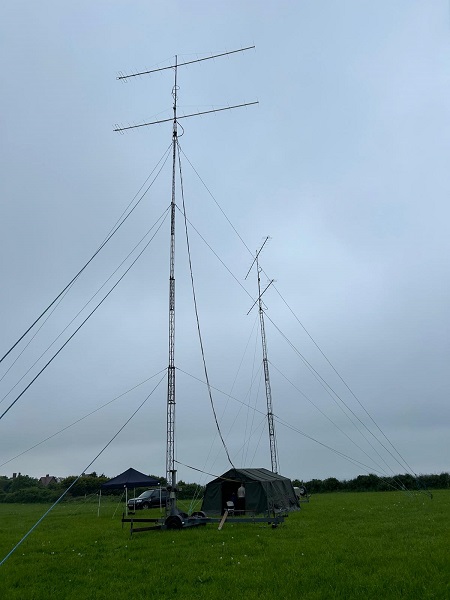Keith M0DZB
Just to follow Tom G8XQD’s piece in Friday’s newsletter, I thought members might be interested in my experience with SSTV from the ISS over the weekend…
Using an FT817 with a handheld Elk antenna, a Signalink interface and MMSSTV, I received several pictures or parts of pictures over half a dozen passes (indoor operation by the way) I also caught the ISS end of an ARISS school contact on Saturday evening using an FT60 and Diamond SRH771 antenna, again indoor operating…
Lots of fun and I shall keep an eye out for future announcements so I can improve the set up and be more prepared!
I’ve just treated myself to a QRP Labs QDX kit, so time to rewatch Hans on NARC Live talking about it… have any other members built a QDX?
I had a play in CQWW SSB at the end of October , single op 10m QRP – raw scores put me middle of the table for that category so pleased with that… trusty G3YLA 10m slim Jim works well!

Professional Audio Mixer desks
A Broadcast Radio Station in Norwich has two substantial Professional desks/benches which they no longer need because of a refit and are looking to give them new homes. These are professional desks made by the Sonifex company and designed for their audio mixers, originally costing several thousand pounds. They have large openings cut in the desks where the mixers were inset so these would need to be covered unless you want to use them for something similar, but there are spare wood panels you could use for this and you will end up with very sturdy and stable benches/desks. The Radio Station would like them to find good homes with maybe just a small donation to their charity if you are able.
The benches are currently stored in Norwich just off Aylsham Road – for details and how to view or collect one or both please contact David G7URP asap – This email address is being protected from spambots. You need JavaScript enabled to view it.


Tom G8XQD…
As previewed on NARC Live 20.11.24:
This permanent electrostatic material is new to me. Something I believe all NARC members will be interested in, as the phenomenon of Electrets is actually used in most current microphones we use for turning voice into electrical energy. (The older alternative microphones use a magnet and coil rather than static electric field).
Computing History in Cambridge
Tom also shares with us this video about the Centre for Computing History in Cambridge
So, here I go again, suggesting our membership might have an interest in my findings from YouTube…
(NB: A great place to visit especially if you enjoy those early days of computing from the 80’s & 90’s – David)
And on the amateur Spectrum…
I just found information regarding (Canada, and or USA?), free use of frequencies around 151.8875MHz, and wondered what the UK use it for. I found this OFCOM full spectrum information, that is new to me, and may be interesting to other club members. I am sure there must be many restrictions to the orange “Licence exempt” portions as shown, and there are many white portions like 47.00MHz to 47.40MHz that I didn’t find the use for.
http://static.ofcom.org.uk/static/spectrum/map.html
Chris G0GGF Silent key equipment
Below are pictures of Chris’s Kenwood TS-2000 multi band all mode transceiver and Yaesu FT-7800 V/UHF radio which are priced to hopefully sell to a local amateur.
Both are in good condition and come with their microphones and manuals. Kim G4WUG is selling these on behalf of the family, so any queries please contact Kim via email: This email address is being protected from spambots. You need JavaScript enabled to view it.


Tom G8XQD
Our thanks to Tom G8XQD for this article:
I thought some club members would like to give this a try.
YouTube video – how to get ISS SSTV images on a phone APP with the audio from a 2M radio!
| November 2024 Space Station SSTV Event #shorts The International Space Station is running a slow-scan TV event until November 18th. It’s pretty easy to tune in and a good way to get started with space radio stuff! Check out https://www.ariss.org/ for more info, https://www.n2yo.com/ for space station tracking, and https://amsat-uk.org/beginners/iss-sstv/ for a how-to guide. Saveitforparts t … www.youtube.com |

